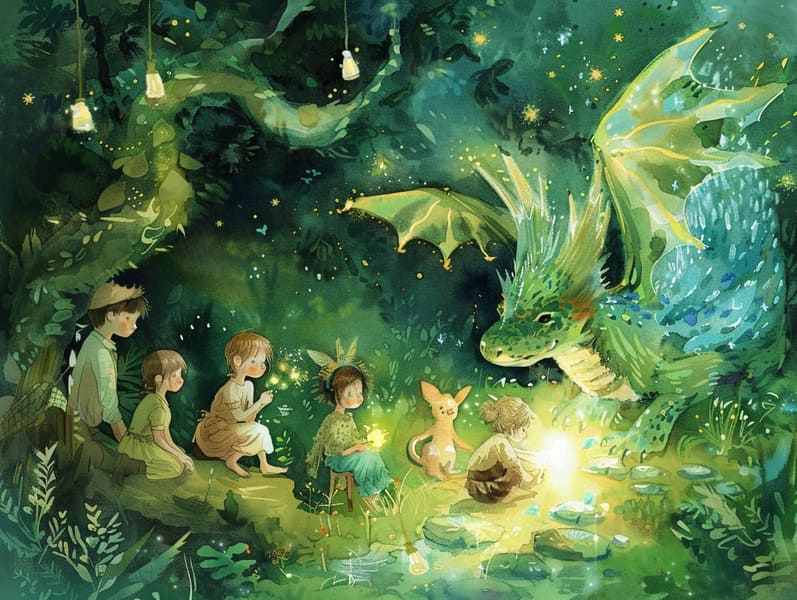The Genesis of Ancient Fairy Tales and Its Unending Allure.
The Genesis of Ancient Fairy Tales and Its Unending Allure.
Blog Article

Fairy tales have deep roots. These tales have been conveyed from one generation to the next millennia before they were ever recorded. They came from a variety of traditions, including Western traditions. They were initially disseminated among older generations, often carrying themes and messages relevant to the societal norms and beliefs of the time.
The Brothers Grimm, Jacob and Wilhelm Grimm, were among the first to assemble many of these beloved stories. Their volume, "Grimm's Fables," included narratives like "Ashenputtel," "The Bread Crumb Trail," and "Schneewittchen," which have since become essentials in the world of children's fairy tales. Similarly, Hans Andersen's imaginative stories, such as "The Mermaid," and "The Ugly Duckling," have enchanted hearts worldwide, guaranteeing their place in the pantheon of iconic fairy tales.
Though they are centuries old, fairy tales remain as pertinent as ever, especially as kids' bedtime tales. These magical stories are now available in various formats, including vibrantly illustrated books, enchanting animations, and digital fairy tales.
Their continued relevance can be traced to several delightful features:
Key Lessons: Ancient fairy tales often provide important moral lessons. Narratives like "The Story of the Boy Who Cried Wolf" teach the virtue of truth, while "The Hare and the Tortoise" stress the benefits of persistence and meekness. These stories offer little ones clear distinctions between right and wrong, forming their moral compass in a tender yet profound way.
Kindness and Comprehension: Fairy tales frequently depict figures facing challenges and struggles, stimulating young readers to comprehend with their struggles and support their triumphs. For instance, "The Tale of Beauty and the Beast" reveals the significance of seeing beyond looks to know the real person of a character, promoting sympathy and appreciation.
Cultural Recognition: Many traditional fairy tales are steeped in the cultural contexts from which they came. Engaging with these tales can provide captivating looks into different social structures, fostering a sense of world understanding and respect.
Fantasy and Imagination: The mythical elements in old fairy tales—fairy godmothers—revitalize children’s imaginations. These stories lead readers to imaginary realms, promoting creative ideas and a sense of excitement that remains a lifetime.
Ancient fairy tales are not only delightful but also pedagogical. They work as charming tools in nurturing various brain and heart skills in children. When ancient fairy tales are narrated, they improve language development by presenting new words and intricate sentence structures. This practice also strengthens hearing abilities and attention, as kids stay focused, eager to see what happens next.
Furthermore, exploring the themes and characters of timeless fairy tales can cultivate evaluative skills and reasoning skills. Little ones learn to discern patterns, expect results, and grasp cause and effect. These discussions also facilitate young ones verbalize their thoughts and feelings, cultivating their emotional intelligence.
In today’s high-tech era, the proliferation of free fairy tales online has made these narratives more attainable than ever. Online platforms and web apps make available comprehensive collections of classic fairy tales that can be accessed or heard anytime, anywhere. Fairy tales read out loud are particularly well-liked, supplying an delightful method for children to engage with these whimsical stories. Sound books and voiced videos take characters and settings to life, often joined by captivating melodies and songs that enhance the storytelling journey.
The timeless appeal of ancient fairy tales lies in their ability to transform to current eras while sustaining their basic principles. Contemporary retellings of these fairy tales often incorporate more different protagonists and modern settings, making them relatable to today’s audience. However, the basic principles of courage, sympathy, and honesty remain unchanged, continuing to resonate with young readers of all ages.
Classic fairy tales also offer a sense of calm and knownness. They extend a organized narrative with a recognizable beginning, middle, and end, often concluding with the conclusion of conflicts and the triumph of virtue over wickedness. This dependability can be heartening for children, imparting a sense of consistency in an always shifting world.
Timeless fairy tales continue to enchant and teach new generations, maintaining their radiance and value in modern society. As bedtime stories for kids, they impart a perfect blend of charm and enlightenment, fostering moral values, empathy, and creativity. The proliferation of digital fairy tales and the favor of fairy tales narrated warrant that these classic narratives remain reachable to new generations.
By safeguarding and passing on these stories, we continue to esteem the rich tapestry of inventiveness and cultural heritage. Whether you are delving into a gorgeously illustrated book, perusing a web-based library, or hearing an narrated book, the wonder of popular fairy tales is always within reach. These stories remind us of the invariable power of online fairy tales for free storytelling and its ability to bring us together across epochs and places.
No matter if you are perusing a artistically illustrated book, exploring a web-based collection, or listening through an voice book, the wonder of children's fairy tales is always within reach.
These narratives illustrate of the enduring power of storytelling and its ability to link us across generations and cultures, making a tie that fascinates and enlightens alike.